The content of this website is no longer being updated. For information on current assessment activities, please visit http://www.globalchange.gov/what-we-do/assessment
Coasts
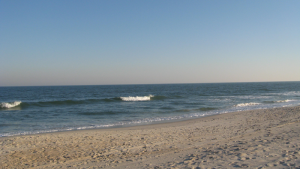 Approximately one-third of all Americans live in counties immediately bordering the nation’s ocean coasts.1,2 In addition to accommodating major cities, the coasts and the exclusive economic zone extending 200 miles offshore provide enjoyment, recreation, seafood, transportation of goods, and energy. Coastal and ocean activities contribute more than $1 trillion to the nation’s gross domestic product and the ecosystems hold rich biodiversity and provide invaluable services.3 However, intense human uses have taken a toll on coastal environments and their resources. Many fish stocks have been severely diminished by over-fishing, large “dead zones” depleted of oxygen have developed as a result of pollution by excess nitrogen runoff, toxic blooms of algae are increasingly frequent, and coral reefs are badly damaged or becoming overgrown with algae. About half of the nation’s coastal wetlands have been lost – and most of this loss has occurred during the past 50 years.
Approximately one-third of all Americans live in counties immediately bordering the nation’s ocean coasts.1,2 In addition to accommodating major cities, the coasts and the exclusive economic zone extending 200 miles offshore provide enjoyment, recreation, seafood, transportation of goods, and energy. Coastal and ocean activities contribute more than $1 trillion to the nation’s gross domestic product and the ecosystems hold rich biodiversity and provide invaluable services.3 However, intense human uses have taken a toll on coastal environments and their resources. Many fish stocks have been severely diminished by over-fishing, large “dead zones” depleted of oxygen have developed as a result of pollution by excess nitrogen runoff, toxic blooms of algae are increasingly frequent, and coral reefs are badly damaged or becoming overgrown with algae. About half of the nation’s coastal wetlands have been lost – and most of this loss has occurred during the past 50 years.
Global climate change imposes additional stresses on coastal environments. Rising sea level is already eroding shorelines, drowning wetlands, and threatening the built environment.4,5 The destructive potential of Atlantic tropical storms and hurricanes has increased since 1970 in association with increasing Atlantic sea surface temperatures, and it is likely that hurricane rainfall and wind speeds will increase in response to global warming.6 Coastal water temperatures have risen by about 2°F in several regions, and the geographic distributions of marine species have shifted.7,8,9 Precipitation increases on land have increased river runoff, polluting coastal waters with more nitrogen and phosphorous, sediments, and other contaminants. Furthermore, increasing acidification resulting from the uptake of carbon dioxide by ocean waters threatens corals, shellfish, and other living things that form their shells and skeletons from calcium carbonate10 (see Ecosystems sector). All of these forces converge and interact at the coasts, making these areas particularly sensitive to the impacts of climate change.
Sea-level Rise
Significant sea-level rise and storm surge will adversely affect coastal cities and ecosystems around the nation; low-lying and subsiding areas are most vulnerable.
The rise in sea level relative to the land surface in any given location is a function of both the amount of global average sea-level rise and the degree to which the land is rising or falling. During the past century in the United States, relative sea level changes ranged from falling several inches to rising as much as 2 feet.11 High rates of relative sea-level rise, coupled with cutting off the supply of sediments from the Mississippi River and other human alterations, have resulted in the loss of 1,900 square miles of Louisiana’s coastal wetlands during the past century, weakening their capacity to absorb the storm surge of hurricanes such as Katrina.12 Shoreline retreat is occurring along most of the nation’s exposed shores.
Multiple Stresses Confront Coastal Regions
Various forces of climate change at the coasts pose a complex array of management challenges and adaptation requirements. For example, relative sea level is expected to rise at least 2 feet in Chesapeake Bay (located between Maryland and Virginia) where the land is subsiding, threatening portions of cities, inhabited islands, most tidal wetlands, and other low-lying regions. Climate change also will affect the volume of the bay, its salinity distribution and circulation, as will changes in precipitation and freshwater runoff. These changes, in turn, will affect summertime oxygen depletion and efforts to reduce the agricultural nitrogen runoff that causes it. Meanwhile the warming of the bay’s waters will make survival there difficult for northern species such as eelgrass and soft clams, while allowing southern species and invaders riding in ships’ ballast water to move in and change the mix of species that are caught and must be managed. Additionally, more acidic waters resulting from rising carbon dioxide levels will make it difficult for oysters to build their shells and will complicate the recovery of this key species.13
Projected Sea-Level Rise by 2100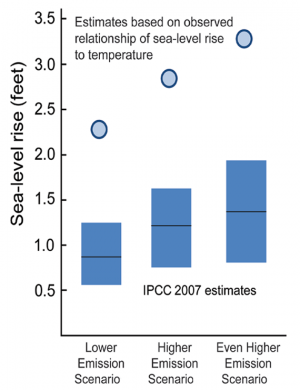 Estimates of sea-level rise by the end of the century for three emissions scenarios.14 Intergovernmental Panel on Climate Change 2007 projections (range shown as bars) exclude changes in ice sheet flow.15 Light blue circles represent more recent, central estimates derived using the observed relationship of sea-level rise to temperature.16 Areas where coastal land is sinking, for example by as much as 1.5 feet in this century along portions of the Gulf Coast, would experience that much additional sea-level rise relative to the land.17 Image References: Meehl et al.15, Rahmstorf16
Estimates of sea-level rise by the end of the century for three emissions scenarios.14 Intergovernmental Panel on Climate Change 2007 projections (range shown as bars) exclude changes in ice sheet flow.15 Light blue circles represent more recent, central estimates derived using the observed relationship of sea-level rise to temperature.16 Areas where coastal land is sinking, for example by as much as 1.5 feet in this century along portions of the Gulf Coast, would experience that much additional sea-level rise relative to the land.17 Image References: Meehl et al.15, Rahmstorf16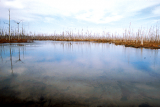 A “ghost swamp” in south Louisiana shows the effects of saltwater intrusion.The amount of sea-level rise likely to be experienced during this century depends mainly on the expansion of the ocean volume due to warming and the response of glaciers and polar ice sheets. Complex processes control the discharges from polar ice sheets and some are already producing substantial additions of water to the ocean.18 Because these processes are not well understood, it is difficult to predict their future contributions to sea-level rise.15,19
A “ghost swamp” in south Louisiana shows the effects of saltwater intrusion.The amount of sea-level rise likely to be experienced during this century depends mainly on the expansion of the ocean volume due to warming and the response of glaciers and polar ice sheets. Complex processes control the discharges from polar ice sheets and some are already producing substantial additions of water to the ocean.18 Because these processes are not well understood, it is difficult to predict their future contributions to sea-level rise.15,19
As discussed in the Global Climate Change section, recent estimates of global sea-level rise substantially exceed the IPCC estimates, suggesting sea-level rise between 3 and 4 feet in this century. Even a 2-foot rise in relative sea level over a century would result in the loss of a large portion of the nation’s remaining coastal wetlands, as they are not able to build new soil at a fast enough rate.20 Accelerated sea-level rise would affect seagrasses, coral reefs, and other important habitats. It would also fragment barrier islands, and place into jeopardy existing homes, businesses, and infrastructure, including roads, ports, and water and sewage systems. Portions of major cities, including Boston and New York, would be subject to inundation by ocean water during storm surges or even during regular high tides.21
Increased Runoff and Warmer Waters
More spring runoff and warmer coastal waters will increase the seasonal reduction in oxygen resulting from excess nitrogen from agriculture.
Dead Zones in the Chesapeake Bay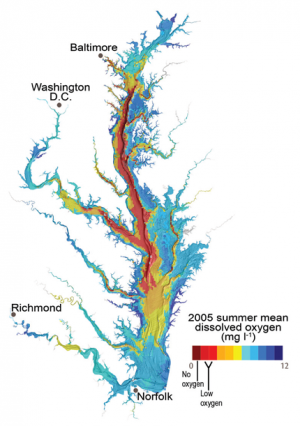 Climate change is likely to expand and intensify “dead zones,” areas where bottom water is depleted of dissolved oxygen because of nitrogen pollution, threatening living things. Image Reference: Wicks et al.22Coastal dead zones in places such as the northern Gulf of Mexico23 and the Chesapeake Bay24 are likely to increase in size and intensity as warming increases unless efforts to control runoff of agricultural fertilizers are redoubled. Greater spring runoff into East Coast estuaries and the Gulf of Mexico would flush more nitrogen into coastal waters stimulating harmful blooms of algae and the excess production of microscopic plants that settle near the seafloor and deplete oxygen supplies as they decompose. In addition, all else being equal, greater runoff reduces salinity, which when coupled with warmer surface water increases the difference in density between surface and bottom waters, thus preventing the replacement of oxygen in the deeper waters. As dissolved oxygen levels decline below a certain level, living things cannot survive. They leave the area if they can, and die if they cannot.
Climate change is likely to expand and intensify “dead zones,” areas where bottom water is depleted of dissolved oxygen because of nitrogen pollution, threatening living things. Image Reference: Wicks et al.22Coastal dead zones in places such as the northern Gulf of Mexico23 and the Chesapeake Bay24 are likely to increase in size and intensity as warming increases unless efforts to control runoff of agricultural fertilizers are redoubled. Greater spring runoff into East Coast estuaries and the Gulf of Mexico would flush more nitrogen into coastal waters stimulating harmful blooms of algae and the excess production of microscopic plants that settle near the seafloor and deplete oxygen supplies as they decompose. In addition, all else being equal, greater runoff reduces salinity, which when coupled with warmer surface water increases the difference in density between surface and bottom waters, thus preventing the replacement of oxygen in the deeper waters. As dissolved oxygen levels decline below a certain level, living things cannot survive. They leave the area if they can, and die if they cannot.
Coastal waters are very likely to continue to warm by as much 4 to 8°F in this century, both in summer and winter.21 This will result in a northward shift in the geographic distribution of marine life along the coasts; this is already being observed.25,9 The shift occurs because some species cannot tolerate the higher temperatures and others are out-competed by species from farther south moving in.26 Warming also opens the door to invasion by species that humans are intentionally or unintentionally transporting around the world, for example in the ballast water carried by ships. Species that were previously unable to establish populations because of cold winters are likely to find the warmer conditions more welcoming and gain a foothold,27 particularly as native species are under stress from climate change and other human activities. Non-native clams and small crustaceans have already had major effects on the San Francisco Bay ecosystem and the health of its fishery resources.28
Ocean Acidification
Higher water temperatures and ocean acidification due to increasing atmospheric carbon dioxide will present major additional stresses to coral reefs, resulting in significant die-offs and limited recovery.
Calcium Carbonate Saturation in Ocean Surface Waters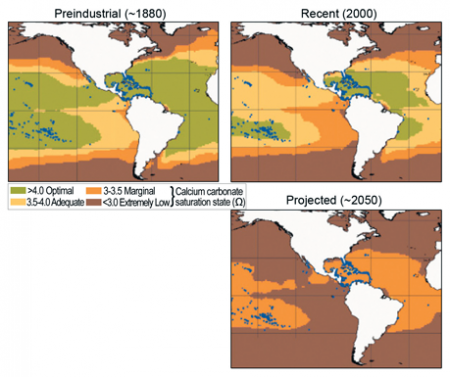 Corals require the right combination of temperature, light, and the presence of calcium carbonate (which they use to build their skeletons). As atmospheric carbon dioxide levels rise, some of the excess carbon dioxide dissolves into ocean water, reducing its calcium carbonate saturation. As the maps indicate, calcium carbonate saturation has already been reduced considerably from its pre-industrial level, and model projections suggest much greater reductions in the future. The blue dots indicate current coral reefs. Note that under projections for the future, it is very unlikely that calcium carbonate saturation levels will be adequate to support coral reefs in any U.S. waters.29 Image Reference: NAST29In addition to carbon dioxide’s heat-trapping effect, the increase in its concentration in the atmosphere is gradually acidifying the ocean. About one-third of the carbon dioxide emitted by human activities has been absorbed by the ocean, resulting in a decrease in the ocean’s pH. Since the beginning of the industrial era, ocean pH has declined demonstrably and is projected to decline much more by 2100 if current emissions trends continue. Further declines in pH are very likely to continue to affect the ability of living things to create and maintain shells or skeletons of calcium carbonate. This is because at a lower pH less of the dissolved carbon is available as carbonate ions (see Global Climate Change).25,30
Corals require the right combination of temperature, light, and the presence of calcium carbonate (which they use to build their skeletons). As atmospheric carbon dioxide levels rise, some of the excess carbon dioxide dissolves into ocean water, reducing its calcium carbonate saturation. As the maps indicate, calcium carbonate saturation has already been reduced considerably from its pre-industrial level, and model projections suggest much greater reductions in the future. The blue dots indicate current coral reefs. Note that under projections for the future, it is very unlikely that calcium carbonate saturation levels will be adequate to support coral reefs in any U.S. waters.29 Image Reference: NAST29In addition to carbon dioxide’s heat-trapping effect, the increase in its concentration in the atmosphere is gradually acidifying the ocean. About one-third of the carbon dioxide emitted by human activities has been absorbed by the ocean, resulting in a decrease in the ocean’s pH. Since the beginning of the industrial era, ocean pH has declined demonstrably and is projected to decline much more by 2100 if current emissions trends continue. Further declines in pH are very likely to continue to affect the ability of living things to create and maintain shells or skeletons of calcium carbonate. This is because at a lower pH less of the dissolved carbon is available as carbonate ions (see Global Climate Change).25,30
Ocean acidification will affect living things including important plankton species in the open ocean, mollusks and other shellfish, and corals.31,10,25,30 The effects on reef-building corals are likely to be particularly severe during this century. Coral calcification rates are likely to decline by more than 30 percent under a doubling of atmospheric carbon dioxide concentrations, with erosion outpacing reef formation at even lower concentrations.31 In addition, the reduction in pH also affects photosynthesis, growth, and reproduction. The upwelling of deeper ocean water, deficient in carbonate, and thus potentially detrimental to the food chains supporting juvenile salmon has recently been observed along the U.S. West Coast.30
Acidification imposes yet another stress on reef-building corals, which are also subject to bleaching – the expulsion of the microscopic algae that live inside the corals and are essential to their survival – as a result of heat stress25 (see Ecosystems sector and Islands region). As a result of these and other stresses, the corals that form the reefs in the Florida Keys, Puerto Rico, Hawaii, and the Pacific Islands are projected to be lost if carbon dioxide concentrations continue to rise at their current rate.32
Ocean Currents and Coastal Ecosystems
Changing ocean currents will affect coastal ecosystems.
Pacific Coast Dead Zones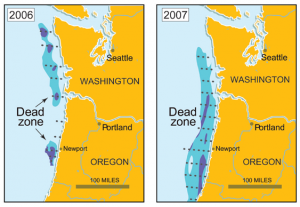 Climate change affects coastal currents that moderate ocean temperatures and the productivity of ecosystems. As such, it is believed to be a factor in the low-oxygen “dead zone” that has appeared along the coast of Washington and Oregon in recent years.33 In the maps above, blue indicates low-oxygen areas and purple shows areas that are the most severely oxygen depleted. Image References: PISCO; NOAA-NWFSC; OSU/COAS34Because it affects the distribution of heat in the atmosphere and the oceans, climate change will affect winds and currents that move along the nation’s coasts, such as the California Current that bathes the West Coast from British Columbia to Baja California.25 In this area, wind-driven upwelling of deeper ocean water along the coast is vital to moderation of temperatures and the high productivity of Pacific Coast ecosystems. Coastal currents are subject to periodic variations caused by the El Niño-Southern Oscillation and the Pacific Decadal Oscillation, which have substantial effects on the success of salmon and other fishery resources. Climate change is expected to affect such coastal currents, and possibly the larger scale natural oscillations as well, though these effects are not yet well understood. The recent emergence of oxygen-depletion events on the continental shelf off Oregon and Washington (a dead zone not directly caused by agricultural runoff and waste discharges such as those in the Gulf of Mexico or Chesapeake Bay) is one example.33
Climate change affects coastal currents that moderate ocean temperatures and the productivity of ecosystems. As such, it is believed to be a factor in the low-oxygen “dead zone” that has appeared along the coast of Washington and Oregon in recent years.33 In the maps above, blue indicates low-oxygen areas and purple shows areas that are the most severely oxygen depleted. Image References: PISCO; NOAA-NWFSC; OSU/COAS34Because it affects the distribution of heat in the atmosphere and the oceans, climate change will affect winds and currents that move along the nation’s coasts, such as the California Current that bathes the West Coast from British Columbia to Baja California.25 In this area, wind-driven upwelling of deeper ocean water along the coast is vital to moderation of temperatures and the high productivity of Pacific Coast ecosystems. Coastal currents are subject to periodic variations caused by the El Niño-Southern Oscillation and the Pacific Decadal Oscillation, which have substantial effects on the success of salmon and other fishery resources. Climate change is expected to affect such coastal currents, and possibly the larger scale natural oscillations as well, though these effects are not yet well understood. The recent emergence of oxygen-depletion events on the continental shelf off Oregon and Washington (a dead zone not directly caused by agricultural runoff and waste discharges such as those in the Gulf of Mexico or Chesapeake Bay) is one example.33
Adaptation: Coping with Sea-Level Rise
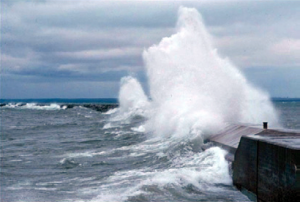 Adaptation to sea-level rise is already taking place in three main categories: (1) protecting the coastline by building hard structures such as levees and seawalls (although hard structures can, in some cases, actually increase risks and worsen beach erosion and wetland retreat), (2) accommodating rising water by elevating or redesigning structures, enhancing wetlands, or adding sand from elsewhere to beaches (the latter is not a permanent solution, and can encourage development in vulnerable locations), and (3) planned retreat from the coastline as sea level rises.35
Adaptation to sea-level rise is already taking place in three main categories: (1) protecting the coastline by building hard structures such as levees and seawalls (although hard structures can, in some cases, actually increase risks and worsen beach erosion and wetland retreat), (2) accommodating rising water by elevating or redesigning structures, enhancing wetlands, or adding sand from elsewhere to beaches (the latter is not a permanent solution, and can encourage development in vulnerable locations), and (3) planned retreat from the coastline as sea level rises.35
Several states have laws or regulations that require setbacks for construction based on the planned life of the development and observed erosion rates.36 North Carolina, Rhode Island, and South Carolina are using such a moving baseline to guide planning. Maine’s Coastal Sand Dune Rules prohibit buildings of a certain size that are unlikely to remain stable with a sea-level rise of 2 feet. The Massachusetts Coastal Hazards Commission is preparing a 20-year infrastructure and protection plan to improve hazards management and the Maryland Commission on Climate Change has recently made comprehensive recommendations to reduce the state’s vulnerability to sea-level rise and coastal storms by addressing building codes, public infrastructure, zoning, and emergency preparedness. Governments and private interests are beginning to take sea-level rise into account in planning levees and bridges, and in the siting and design of facilities such as sewage treatment plants (see Adaptation box in Northeast region).
References
- 1. [549] Crowell, M., S. Edelman, K. Coulton, and S. McAfee. "How Many People Live in Coastal Areas?" Journal of Coastal Research 23, no. 5 (2007): iii-vi.
- 2. [550] Gill, S. K., R. Wright, J. G. Titus, R. Kafalenos, K. Wright, K. E. Anderson, D. R. Cahoon, D. B. Gesch, B. T. Gutierrez, E. R. Thieler et al. "Population, Land Use, and Infrastructure." In Coastal Elevations and Sensitivity to Sea-level Rise: A Focus on the Mid-Atlantic Region, 105-116. Vol. Synthesis and Assessment Product 4.1. Washington, D.C.: U. S. Environmental Protection Agency, 2009.
- 3. [551] on Policy, Commission Ocean U. S.. An Ocean Blueprint for the 21st Century. Washington, D.C.: U.S. Commission on Ocean Policy, 2004.
- 4. [43] Williams, S. J., B. T. Gutierrez, J. G. Titus, S. K. Gill, D. R. Cahoon, E. R. Thieler, K. E. Anderson, D. FitzGerald, V. R. Burkett, J. P. Samenow et al. "Sea-level Rise and Its Effects on the Coast." In Coastal Elevations and Sensitivity to Sea-level Rise: A Focus on the Mid-Atlantic Region, 11-24. Vol. Synthesis and Assessment Product 4.1. Washington, D.C.: U.S. Environmental Protection Agency, 2009.
- 5. [224] Burkett, V. R., R. C. Hyman, R. Hagelman, S. B. Hartley, M. Sheppard, T. W. Doyle, D. M. Beagan, A. Meyers, D. T. Hunt, M. K. Maynard et al. "Why Study the Gulf Coast?" In Impacts of Climate Change and Variability on Transportation Syetmes and Infrastructure: Gulf Coast Study, Phase I, edited by M. J. Savonis, V. R. Burkett and J. R. Potter, 2-1 to 2F-26 [66 pp.]. Vol. Synthesis and Assessment Product 4.7. Washington, D.C.: U.S. Department of Transportation, 2008.
- 6. [112] Kunkel, K., P. D. Bromirski, H. E. Brooks, T. Cavazos, A. V. Douglas, D. R. Easterling, K. Emanuel, P.Ya. Groisman, G. J. Holland, T. R. Knutson et al. "Observed Changes in Weather and Climate Extremes." In Weather and Climate Extremes in a Changing Climate: Regions of Focus: North America, Hawaii, Caribbean, and U.S. Pacific Islands, edited by T. R. Karl, G. A. Meehl, C. D. Miller, S. J. Hassol, A. M. Waple and W. L. Murray, 35-80. Vol. CCSP Synthesis and Assessment Product 3.3. Washington, D.C.: U.S. Climate Change Science Program, 2008.
- 7. [37] Bindoff, N. L., J. Willebrand, V. Artale, A. Cazenave, JM Gregory, S. Gulev, K. Hanawa, C. Le Quere, S. Levitus, Y. Nojiri et al. "Observations: Oceanic Climate Change and Sea Level." In Climate Change 2007: The Physical Science Basis, edited by S. Solomon, D. Qin, M. Manning, Z. Chen, M. Marquis, K. B. Averyt, M. Tignor and H. L. Miller, 385-432. Vol. Contribution of Working Group I to the Fourth Assessment Report of the Intergovernmental Panel on Climate Change. Cambridge, UK and New York, NY: Cambridge Unversity Press, 2007.
- 8. [68] Gutowski, W. J., G. C. Hegerl, G. J. Holland, T. R. Knutson, L. Mearns, R. J. Stouffer, P. J. Webster, M. F. Wehner, and F. W. Zwiers. "Causes of Observed Changes in Extremes and Projections of Future Changes." In Weather and Climate Extremes in a Changing Climate: Regions of Focus: North America, Hawaii, Caribbean, and U.S. Pacific Islands, edited by T. R. Karl, G. A. Meehl, C. D. Miller, S. J. Hassol, A. M. Waple and W. L. Murray, 81-116. Vol. Synthesis and Assessment Product 3.3. Washington, D.C.: U.S. Climate Change Science Program, 2008.
- 9. a. b. [347] Rosenzweig, C., G. Casassa, D. J. Karoly, A. Imeson, C. Liu, A. Menzel, S. Rawlins, T. L. Root, B. Sequin, and P. Tryjanowski. "Assessment of Observed Changes and Responses in Natural and Managed Systems." In Climate Change 2007: Impacts, Adaptation and Vulnerability, edited by M. L. Parry, O. F. Canziani, J. P. Palutikof, P. J. van der Linden and C. E. Hanson, 79-131. Vol. Contribution of Working Group II to the Fourth Assessment Report of the Intergovernmental Panel on Climate Change. Cambridge, UK and New York, NY: Cambridge University Press, 2007.
- 10. a. b. [23] Orr, JC, V. J. Fabry, O. Aumont, L. Bopp, SC Doney, R. A. Feely, A. Gnanadesikan, N. Gruber, A. Ishida, F. Joos et al. "Anthropogenic ocean acidification over the twenty-first century and its impact on calcifying organisms." Nature 437, no. 7059 (2005): 681-686.
- 11. [225] Peterson, T. C., M. McGuirk, T. G. Houston, A. H. Horvitz, and M. F. Wehner. Climate Variabiltiy and Change with Implications for Transportation. Washington, D.C.: National Research Council, 2008.
- 12. [552] Day, J. W., D. F. Boesch, E. J. Clairain, G. P. Kemp, S. B. Laska, W. J. Mitsch, K. Orth, H. Mashriqui, D. J. Reed, L. Shabman et al. "Restoration of the Mississippi Delta: Lessons from Hurricanes Katrina and Rita." Science 315, no. 5819 (2007): 1679-1684.
- 13. [55] Burke, E. J., S. J. Brown, and N. Christidis. "Modeling the Recent Evolution of Global Drought and Projections for the Twenty-first Century with the Hadley Centre Climate Model." Journal of Hydrometeorology 7, no. 5 (2006): 1113-1125.
- 14. [91] various. footnote 91., 2009.
- 15. a. b. c. [90] Meehl, G. A., T. F. Stocker, W. D. Collins, P. Friedlingstein, A. T. Gaye, JM Gregory, A. Kitoh, R. Knutti, J. M. Murphy, A. Noda et al. "Global Climate Projections." In Climate Change 2007: The Physical Basis, edited by S. Solomon, D. Qin, M. Manning, Z. Chen, M. Marquis, K. B. Averyt, M. Tignor and H. L. Miller, 747-845. Vol. Contribution of Working Group I to the Fourth Assessment Report of the Intergovernmental Panel on Climate Change. Cambridge, UK and New York, NY: Cambridge University Press, 2007.
- 16. a. b. [103] Rahmstorf, S.. "A Semi-empirical Approach to Projecting Future Sea-level Rise." Science 315, no. 5810 (2007): 368-370.
- 17. [128] various. footnote 128., 2009.
- 18. [554] Cazenave, A., K. Dominh, S. Guinehut, E. Berthier, W. Llovel, G. Ramillien, M. Ablain, and G. Larnicol. "Sea Level Budget over 2003-2008: A Reevaluation from GRACE Space Gravimetry, Satellite Altimetry and Argo." Global and Planetary Change 65, no. 1-2 (2009): 83-88.
- 19. [555] Vaughan, D. G., and R. Arthern. "Why Is It Hard to Predict the Future of Ice Sheets?" Science 315, no. 5818 (2007): 1503-1504.
- 20. [164] Field, C., L. D. Mortsch, M. Brklacich, D. L. Forbes, P. Kovacs, J. A. Patz, S. W. Running, and M. J. Scott. "North America." In Climate Change 2007: Impacts Adaptation and Vulnerabiltiy, edited by M. L. Parry, O. F. Canziani, J. P. Palutikof, P. J. van der Linden and C. E. Hanson, 617-652. Vol. Contribution of Working Group II to the Fourth Assessment Report of the Intergovernmental Panel on Climate Change. Cambridge, UK and New York, NY: Cambridge University Press, 2007.
- 21. a. b. [234] Frumhoff, P. C., J. J. McCarthy, J. Melillo, S. C. Moser, and D. Wuebbles. Confronting Climate Change in the U. S. Northeast: Science, Impacts, and Solutions. Vol. Synthesis Report of the Northeast Climate Impacts Assessment. Cambridge, MA: Union of Concerned Scientists, 2007.
- 22. [558] Wicks, C., D. Jasinski, and B. Longstaff. Breath of Life: Dissolved Oxygen in Chesapeake Bay. Oxford, MD: EcoCheck, 2007.
- 23. [556] Justic, D., N. N. Rabalais, and R. E. Turner. "Simulated Responses of the Gulf of Mexico Hypoxia to Variations in Climate and Anthropogenic Nutrient Loading." Journal of Marine Systems 42, no. 2-3 (2003): 115-126.
- 24. [557] Boesch, D. F., V. J. Coles, D. G. Kimmel, and W. D. Miller. "Coastal Dead Zones and Global Climate Change: Ramifications of Climate Change for Chesapeake Bay Hypoxia." In Regional Impacts of Climate Change: Four Case Studies in the United States, 57-70. Arlington, VA: Pew Center for Global Climate Change, 2007.
- 25. a. b. c. d. e. [70] Janetos, A., L. Hansen, D. Inouye, B. P. Kelly, L. Meyerson, B. Peterson, and R. Shaw. "Biodiversity." In The Effects of Climate Change on Agriculture, Land Resources, Water Resources, and Biodiversity in the United States, edited by P. Backlund, A. Janetos, D. Schimel, J. Hatfield, K. Boote, P. Fay, L. Hahn, C. Izaurralde, B. A. Kimball, T. Mader et al., 151-181. Vol. Synthesis and Assessment Product 4.3. Washington, D.C.: U.S. Department of Agriculture, 2008.
- 26. [270] Peterson, C. H., R. T. Barber, K. L. Cottingham, H. K. Lotze, C. A. Simenstad, R. R. Christian, M. F. Piehler, J. Wilson, J. S. Baron, B. Griffith et al. "National Estuaries." In Preliminary Review of Adaptation Options for Climate-sensitive Ecosystems and Resources, edited by S. H. Julius and J. M. West, 7-1 to 7-108. Vol. Synthesis and Assessment Product 4.4. Washington, D.C.: U.S. Environmental Protection Agency, 2008.
- 27. [567] Stachowicz, J. J., J. R. Terwin, R. B. Whitlatch, and R. W. Osman. "Linking Climate Change and Biological Invasions: Ocean Warming Facilitates Nonindigenous Species Invasions." Proceedings of the National Academy of Sciences of the United States of America 99, no. 24 (2002): 15497-15500.
- 28. [559] Kimmerer, W. J., E. Gartside, and J. J. Orsi. "Predation by an Introduced Clam as the Likely Cause of Substantial Declines in Zooplankton of San Francisco Bay." Marine Ecology Progress Series 113, no. 1-2 (1994): 81-93.
- 29. a. b. [219] Team, National Assessment Synthesis. Climate Change impacts on the United States: The Potential Consequences of Climate Variability and Change. Cambridge, UK and New York, NY, 2001.
- 30. a. b. c. [259] Feely, R. A., C. L. Sabine, J. M. Hernandez-Ayon, D. Ianson, and B. Hales. "Evidence for Upwelling of Corrosive "Acidified" Water onto the Continental Shelf." Science 320, no. 5882 (2008): 1490-1492.
- 31. a. b. [22] Society, The Royal. Ocean Acidification Due to Increasing Atmospheric Carbon Dioxide., 2005.
- 32. [560] Carpenter, K. E., M. Abrar, G. Aeby, R. B. Aronson, S. Banks, A. Bruckner, A. Chiriboga, J. Cortes, J. C. Delbeek, L. DeVantier et al. "One-third of Reef-building Corals Face Elevated Extinction Risk from Climate Change and Local Impacts." Science 321, no. 5888 (2008): 560-563.
- 33. a. b. [561] Chan, F., J. A. Barth, J. Lubchenco, A. Kirincich, H. Weeks, W. T. Peterson, and B. A. Menge. "Emergence of Anoxia in the California Current Large Marine Ecosystem." Science 319, no. 5865 (2008): 920.
- 34. [562] various. footnote 562., 2009.
- 35. [269] Titus, J. G., M. Craghan, K. E. Anderson, D. R. Cahoon, D. B. Gesch, S. K. Gill, B. T. Gutierrez, E. R. Thieler, and S. J. Williams. "Shore Protection and Retreat." In Coastal Elevations and Sensitivity to Sea-level Rise: A Focus on the Mid-Atlantic Region, 87-104. Vol. Synthesis and Assessment Product 4.1. Washington, D.C.: U.S. Environmental Protection Agency, 2009.
- 36. [371] Titus, J. G., K. E. Anderson, D. R. Cahoon, D. B. Gesch, S. K. Gill, B. T. Butierrez, E. R. Thieler, and S. J. Williams. "Ongoing Adaptation." In Coastal Elevations and Sensitivity to Sea-level Rise: A Focus on the Mid-Atlantic Region, 157-162. Vol. Synthesis Assessment Product 4.1. Washington, D.C.: U.S. Environmental Protection Agency, 2009.